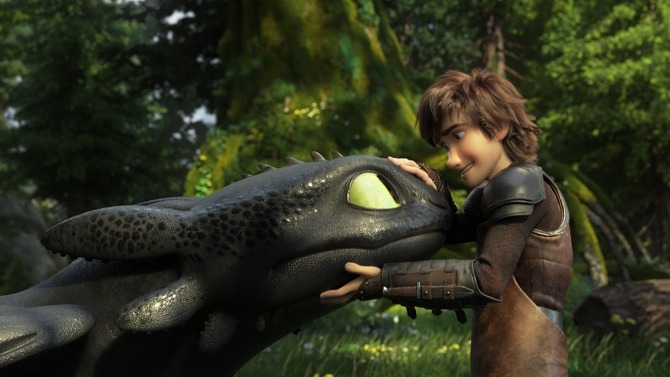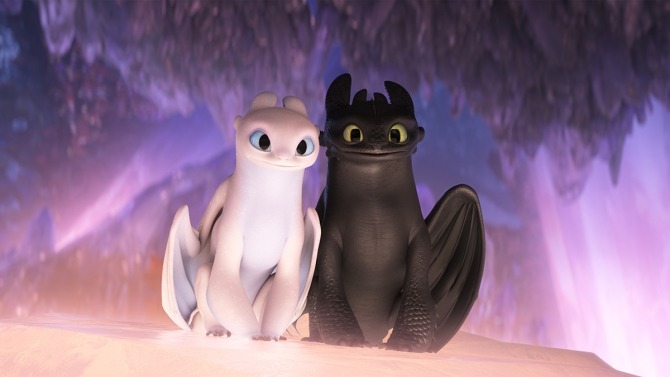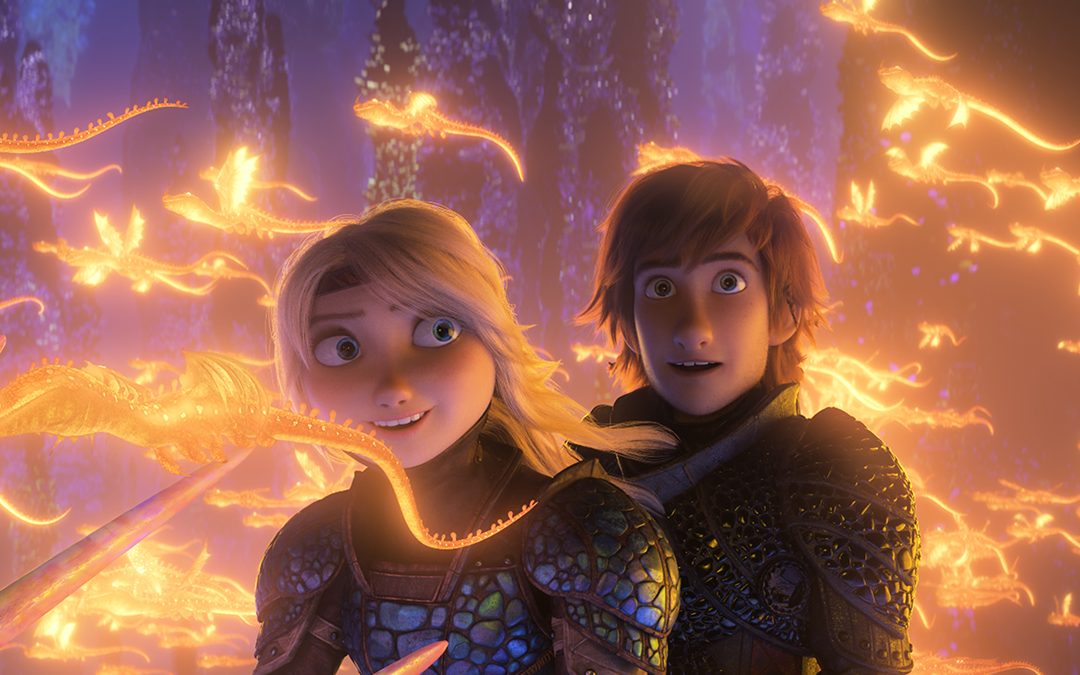After over 10 years of graft across three movies and an eight-season TV show, DreamWorks’ much-loved Dragons franchise is coming to a definitive end with big-screen trilogy closer The Hidden Kingdom. As you might expect, finishing the saga that he started with 2010’s How To Train Your Dragon has been a bittersweet experience for writer/director Dean DeBlois.
“It’s both freeing and sad,” DeBlois tells Den of Geek when we catch up with him in London. “The crew that made this film have largely been together for all three, and so we’re disbanding as a family as the characters are disbanding within the story.”
As the franchise’s chief custodian, though, there’s also a sense of accomplishment about finally saying goodbye to Hiccup, Toothless and the beautiful world of Berk.
“For me personally, there’s great satisfaction in having had the opportunity to do a trilogy,” says DeBlois. “I’m definitely a Star Wars kid – that first trilogy was my inspiration for getting into this business, so it feels really nice to have completed the story. I didn’t want to let it just peter out; to keep making sequels until people have finally had enough and couldn’t stand it anymore. I would rather have a definitive end and leave people wanting more, than for people to slowly lose interest and the [series] to lose its integrity along the way.”
Getting The Hidden World to the big screen hasn’t been without its challenges, though: not only was the third film more technically ambitious than its predecessors, but there was also the little matter of a corporate takeover to navigate (after Dreamworks Animation was bought by Universal in 2016).
Here, DeBlois talks to Den of Geek about the making of the film, dealing with fan expectations and the trouble with live-action remakes of animated films…
The story of Hiccup and Toothless takes place on a grand scale, spanning three movies. Was that always the intention?
When Chris Sanders [the first Dragon‘s co-director] and I were working on the first film, we were just trying to get it to the finish line, so there was no thought of a grander storyline. But in the wake of its success, there was talk of a sequel. I have an allergy to sequels: if they don’t feel like they have a real purpose in advancing the story, I often check out.
So in order to avoid that, I pitched the idea of a trilogy that would map Hiccup’s coming of age from the nuisance runt who we met in the first film through to the wise, selfless chief who was destined to be – and treat those three films as three acts of one story. The studio bought into that. It gave the second and third installments purpose; I knew that by the end, the goal was to get back to history as we know it and close the chapter on this time where dragons roamed the Earth.

You’re wrapping up a series that has a huge and very loyal fan base – did you feel any pressure to make sure they had a fitting goodbye?
Yeah. The Dragon fans are very supportive and vocal and fervent. It has been really interesting and fun to watch it grow ever over the course of the three movies and the TV series that fell between them. People really feel ownership over these characters. And we – the 400 people who made this movie – felt a pressure to live up to those expectations.
The biggest challenge for me was to avoid crapping the bed, as it were. So often, the third installment is a disappointment. I wanted to bring it to a satisfying close that would separate Hiccup and Toothless and all of the Vikings and their dragons in a way that didn’t make the audience hate us. That was tricky, especially being that Hiccup has been preaching coexistence for two movies and here he’s essentially having to embrace the idea of separation.
How did the changeover in management after the Universal deal affect the film?
We had about three years to make the second film; this one’s taken over four. And part of that was largely to do with the handing over of DreamWorks and Universal becoming our new bosses. It wasn’t just the acquisition; it took time for them to evaluate the whole slate of films that were in pre-production and production at DreamWorks. It was a stall for us, but it wasn’t a derailing one. We didn’t have to reconcieve anything, which was great.
How much further have you pushed the technology on this one compared to, say, Dragon 2?
Making this film was very freeing. All of the promise of the tools that we had been gifted on the second movie was fully realised on the third. The new back-end rendering process allowed for very realistic-looking lighting and very speedy results, so we could take on thousands of dragons in a single shot, in an environment that’s illuminated with all sorts of complex light sources.
The Hidden World itself is really an example of how far we’ve come technologically because we couldn’t have attempted that in the first film, and it would have been very difficult to do in the second film. We’ve finally reached a point in the state of computer animation where have the ability to dream up an image and create it without any limitations. There’s nobody on the sidelines saying, “Oh that’s nice, but you’re gonna have to do a scaled-down version because we can’t possibly render that in time.” That’s quite amazing.
Talking about putting your imagination on screen, there are a lot of dragons in this film. How on Earth did you come up with all of the different designs?
I mean it is the fun part of the process for sure – designing dragons and coming up with their abilities and their specific animal references. In reality, we can only ever afford to build about four or five new dragons per film because they’re very complex and time-consuming and thus expensive. But we came up with a modular system on the second film that we’ve continued to refine here, where we can pair different heads with different bodies and different tales and different spikes and create an endless variety of background dragons to populate the place.
But the dragons that really take front and centre are laboured over for months and months, not only in terms of their design but also the model and the articulation, building in all of the bones and muscle and fat so that they can they can really hold up to a close-up.
Some scenes in the film are quite dark, especially when the Deathgrippers are on screen. How far can you push those elements in a film like this?
We have an interesting phenomenon where the audience has grown up with these characters. And in some ways, like with the Harry Potter films, the tone could go a little darker and take on much more mature themes. We just had to be mindful that we weren’t leaving the younger audience behind.
It was always important to me that we never have gratuitous violence, but I wanted this world to feel like it had consequence and peril. If you fell from a great height off the back of a dragon, you wouldn’t bounce and be fine. If you got in the way of dragon fire, you would burn – and consequently, Hiccup loses his leg, a parent dies… So it’s a world that hopefully has a balance of humour and intensity.

One of the film’s standout scenes is the courtship between Toothless and the Light Fury. What were your references for that sequence?
It’s largely modelled on the idea of Cyrano de Bergerac – the friend whispering from the bushes while the amateur tries to woo his love interest. In this case, because Toothless has spent so much time with humans, he’s compromised. The Light Fury is quite pure – she comes from a world of dragons and she’s had very little human influence. We started looking at a lot of bird mating behaviours because they tend to be the most ridiculous. So we channelled quite a few of those into Toothless’ behaviour.
There have been a few directors who are known for animation moving across into live action recently, like Brad Bird and Travis Knight. Is that something you’d want to do?
It definitely is. I’ve wanted to add live action to the toolbox for a long time. Between Lilo & Stitch [DeBlois co-wrote and directed that film with Sanders] and How to Train Your Dragon, I spent about seven years setting up live-action projects to write and direct. And each one kind of hit the rocks. But it has kind of left this open ambition to try it again. I don’t know if it’s the next project that I’ll do – I haven’t actually made any decisions about what’s next. But I do hope that there’s an opportunity in the future to do something in live action that that appeals to my sensibilities and where I could apply the skills I’ve developed in animation.
There has also been a recent trend of remaking classic animated movies into live-action films – even Lilo & Stitch has been mooted for the remake treatment. What’s your take on that?
I find it off-putting, to be honest. In one sense, I think it’s easy because all of the hard work of finding the story and honing it has been done – so now you get to take a movie that’s been a success and just make it in a different medium. But more than that, I feel that the live-action adaptations negate the animated ones in some way; as if to say that they are better than the original. You know, “let us improve upon your flawed medium.” So as somebody who loves animation, I think it loses the charm.
Maybe it appeals to a wider audience – and they certainly do well. So I am probably in the minority. But especially for a film like Lilo & Stitch, which was such a singular, quirky vision – we were basically a group of people trying to make Chris Sanders’ idea for a storybook come to life. And it’s so personal; it’s not an age-old fairytale or a known legend. It’s such a specific story. So to remake it, particularly with a new group of people that weren’t part of that original team… Yeah, that seems like an odd one to me.
How To Train Your Dragon: The Hidden World is out now.

